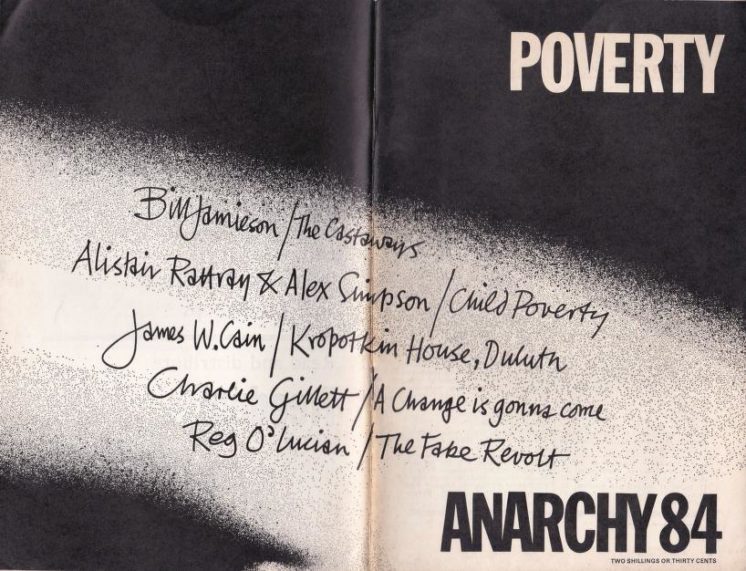Duluth in Anarchy: A Journal of Anarchist Ideas
I found reference to Duluth in Anarchy: A Journal of Anarchist Ideas, issue #84, from February 1968, with a feature about something I have never heard of, the Kropotkin House.
Kropotkin House, Duiuth
James W. Cain
I remember that Monday night when first I stumblcd up the grey, oversized steps of the old house. (Controversy was fresh and flagrant: it was not long after we had distributed over a thousand copies of a broadside — entitled “Blast!” — throughout the city of Duluth on May Day of last year; because of the confusion and excitement, I was invited into the University and several high schools to speak on Anarchism.) I had rented the house from Slumlord Overman without even seeing it. It was the cheapest ghetto-dwelling he had available. It was dirty, disintegrating, Victorian, red-brown brick building; it leaned unassumingly on another building which was exactly like it (which in turn unassumingly leaned on another just like it: the three gave the impression of being one huge rock mound).
When I tried the key, it jammed in the lock and I cursed quite assumingly. On the sidewalk below, a small child in a blue dress was prattling in French-Canadian and an old man with one leg (known locally as “the Polish Fascist”) was surrounded by three barking, leaping dogs. Finally, I opened the door and bundled my few pieces of furniture and baggage into the house. The smell was piercing and pungent: cheap paint, rotting wood, and broken toilet. I felt lonely, apprehensive, tired, and stunned.
A weird, unverbalized, and distorted collage leaped through my mind: I thought of the Diggers in San Francisco (I had been there in February when the police tried to destroy them); I thought of Dorothy Day’s Chrystie Street House of Hospitality in New York and her farm at Tivoli (I had been there in the bitter weeks of early January and the Christmas season); I thought of Emmaus House and Ammon Hennacy’s Joe Hill House; and I thought of a suggestion by Herbert Read: “The General Strike of the future must be organized as a strike of the community against the State. The result of that strike will not be in doubt. The State is just as vulnerable as a human being, and can be killed by the cutting of a single artery. But the event must be catastrophic. Tyranny, whether of a person or a class, can never be destroyed in any other way.” I sighed. I opened a window and, without further ritual, named the house: Peter Kropotkin House of Hospitality.
Since the early part of April, when I had returned to Duluth from the West, I had discussed with friends and activists the idea of someone opening a house in Central Hillside, the ghetto of Duluth, and using it as a place to inject a libertarian perspective of social problems into the area (I was particularly enthusiastic about Herbert Read’s conception). Now, it seemed, my desire was to be actualized (because I had suddenly decided to actualize it myself). I had taken a job as a laundryman at a local hospital in order to provide a financial basis; and, without further promise of aid or assistance, proceeded to open the house.
During the first week of my residency, the nights were spent in cleaning the house. Gary Moland, a pacifist friend, swept and mopped the floors. Kelene Koval (an Anarchist), Bob Pokorney, and Jim McCaffrey exuberantly scrubbed the walls and ceilings. Neighbours, timidly at first, but with growing confidence, provided mutual aid (even “the Polish Fascist”). Propaganda was not needed; their curiosity (and their loneliness) brought them. A great crowd of students (most of whom had heard me speak on Anarchism at their respective schools) came, barefooted and wearing cut-offs, eager to talk and work but mostly to talk (about God mostly and the State—and sometimes Capitalism). I provoked one young fellow into reading Kropotkin’s Memoirs of a Revolutionist, and a University student read Maximoff’s anthology of Bakunin’s writings.
Most of the old people who came from the neighbourhood to work at the house were extremely aggravated by the young people. One wrinkled woman, an alcoholic, told me that she was afraid of a Red Guard riot. I told her that she had no reason to worry: the students are quite conventional and mostly middle-class; they would be more likely to riot for Hubert Humphrey than for Mao. In either case (said I) it would be definitely reactionary. (I was perhaps too brutal: many young minds were just awakening to a commitment against segregation and the war in Vietnam.) The poor woman said she couldn’t understand and decided to go out and get something to drink.
By this time, about half a dozen people were staying more or less regularly at the house. Someone had given us a bed; someone had given us a sleeping-cot. We began to make preparations for a series of “gatherings” in Cascade Park (on the edge of the ghetto).
I do not wish to give the impression that life at Kropotkin House was all gentle, beautiful, sensitive, serene, and unruffled. I had to stay up all night once with a raving “druggie” who couldn’t find enough money to pay for his particular escape. All that this friendless creature of paranoia wanted was to find someone who would talk with him. (I actually fell asleep on my feet in the laundry the next day; but, ever since, I have had little patience for crude Calvinists who call for more laws and stricter punishment against drug-addicts.)
About a month after the house was opened, Kai Johnson, an Anarchist and pacifist, bought some paints and proceeded to paint murals on the walls of two of the upstairs rooms. I painted the door of my room black with brilliant red panels. The Benedictine Sisters of the Sacred Heart (a local convent in the ghetto) discovered the house and, even though they did not approve of me, were quite impressed with the idea and donated two desks, seven chairs, an old French writing- table and a Bible. Nina Garber, an Anarchist, baked bread for the always hungry people of the house; and, one night, Esme Evans, a folk-singer of some renown in the Upper Midwest, arrived with a massive meal of beef stroganoff, salads, and wine (by this time, and until its closing, there were usually over fifty people in the house every night). Many of us became sick from the good food.
A few days after our “gathering” on July 19 in Cascade Park in honour of the Anarchists in Spanish prisons, a Mexican-American homosexual, a manic-depressive of sorts, decided he wanted to commit suicide in the house; although the attempt failed, there was still a considerable amount of chaos, confusion, and angry people.
Some of the teenage boys in the neighbourhood saw Kai painting one day and they patiently waited until no one was in the house and then climbed through the second-storey window (even though the door was always open, they always showed a preference to enter through the second-storey window) and painted a hideous mural that covered all of the walls and ceiling of the “Mrs. Murphy”. They were quite proud of their work. Their own parents objected. The boys were confident; they merely quoted one of the regulations of Kropotkin House: “This house is dedicated to providing the possibility for anyone to initiate creative activity.”
One night, a prostitute was beaten bloody and thrown out of a moving car in front of the house. She refused to go to the hospital; she wanted to stay at the house until her wounds were healed: she stayed at the house until her wounds were healed: she stayed until the house was closed. Several people of the house were continually denouncing her as a thief; she would quietly respond: “It will all come out in the end.” Last week, the police found her bloodied body. She had been mauled and abandoned in a gutter again.
The hippies came in procession one evening and presented me with great bunches of red roses and lilacs and named me: “the Digger”.
When I finally lost my job (I was most imprudent: they caught me disseminating information about workers’ control and the war in Vietnam) and we needed money for the house, we sent an appeal for support to over 500 people (humanists, as it were) in the area. I quote from it to give some idea of the simple and basic principles we tried to activate:
“Central Hillside, Duluth, Minnesota, is a community facing enormous human problems: poor housing and high rents, social and emotional isolation and anguish, insufficient income and inflating prices, deteriorating family life, violence, loneliness, fragmented educational and cultural attempts, and racial injustice. Central Hillside is a symbol of urban man’s suffering and desperation—and of his hopes.
“Now the terrifying paradox of the whole thing is this: Central Hillside, and every person in it, is a living condemnation and exhortation of the city of Duluth. For it is here, in Central Hillside, that we find a new situation of urban man, with its environment of isolation and dehumanization, which is beginning to shape the desire for new structures, new patterns, new forms of renewed and activized life. There is talk now of ‘turning Central Hillside inside out’, of a burst of new energy and life as the community discovers ideas and forms that are relevant to the vast shapes of need and strength, of hope and despair. Both the world of Central Hillside and the power of love and joy are forcing the city of Duluth to face the need for radical and creative renewal and reformation. Peter Kropotkin House of Hospitality is a sign of new shapes and values in the community of Central Hillside and in the city of Duluth.
“Peter Kropotkin House of Hospitality is a gathering place for those people who are concerned about the problems of Central Hillside and desire to contribute to its social and emotional growth and reformation. The house is named in honour of Peter Kropotkin, the great writer and activist of the anarchist movement, who taught the necessity of personalized and functional communities as means of enjoying life and resisting blatant totalitarianism (as in China and the Soviet Union)
and creeping centralization (as is England and the United States). We are a group of neighbours and friends who seek to be available in their community day after day, day in and day out. Our gathering of friends and neighbours is flexible, pluralistic, ad hoc. and dispensable. We do not desire to establish the same old formalized structures and programmes. We do not receive money from any institution. We do not receive money from the Government. We do not receive money from any corporation. We believe that the people of Central Hillside must solve their own problems through direct action.
“Peter Kropotkin House of Hospitality is always open and ready to welcome anyone. It is a place where individuals and families in need come to stay for a while; it is a place where persons interested in this Icmdl of action may come and see and talk for a time. Here, the mutilated, the addicted, and the healthy, the affluent and the poor, black, red, and white, unpolitical and radical come together and realize that they must link themselves in mutual aid, and together in friendship seek out a pattern of hying which is more just, more creative, more personalistic and more realistic for our community of Central Hillside in the modern world.
One young girl (who, like other black people I have met in the ghetto, was passionately committed to working for human rights and equally convinced that American troops should be withdrawn from Vietnam immediately) spent two hours one afternoon trying to persuade me that I should organize riots in Duluth during the summer; she did not succeed.
In the latter part of July and the beginning of August, I was in Canada and Minneapolis to fulfil several speaking engagements. When I got back to Duluth, there were rumours of impending riots (Duluth IS the only city in the Midwest that allows “the Job Corps boys”—who mostly represent the minority races—to enter and walk upon its sacred ground.) The SNCC agitators were agitating the riots, said the rumours Bilge water, said I. A meeting was called of all “Humanitarians” to discuss what should be done. At the meeting, I expressed doubt that there had been any agitation (not that I wouldn’t put it past SNCC’s perverse view of revolution: there just weren’t any SNCC agitators; and the black people in the ghetto, although angry were organizing for possibility and not futility. The Revolution is the Revolution: It IS the attempt to use mutual aid institutions, labour syndicates and revolutionary co-operatives to create a new society while destroying the old; It IS not an adolescent spree for loot and booty that places the responsibility for the reorganization of society on the greasy finger-tips of the leaders—whether they be politicians of “black power” or politicians of “great society”). They were a little late (said I) in worrying about the black people now; they could have done something constructive and fraternal about the segregation situation before the summer but now basically—they were only worried about the threat to their private property. I said that it would be barbarous to call out the military. Someone denounced me as an obstructionist. She wanted a harm policy. I have since wondered whether she was disappointed: there weren’t any riots in Duluth during the summer.
[Segment missing here]
Kropotkin House was closed in September. We had gone into a considerable amount of debt (our appeal failed: the Chamber of Commerce had formally and uninvitedly opposed us; we were not worthy of aid), we had no support (moral or otherwise) from other Anarchists in America, and there were difficulties (sanitation, sedition, etc.) with the Department of Water, Gas, and Sewage Treatment—and other governmental bureaus. Our accomplishments are rather intangible (all that I could definitely describe would be some small assistance in the campaign of the residents of the ghetto to resist City Hall by building an illegal playground for their children). Our failures are many: lack of understanding, lack of solidarity, lack of propaganda (there are still a few people that refer to Kropotkin House as “the Communist Whorehouse”), lack of endurance, etc., etc. I am convinced, however, that there is definite need and a necessity for Anarchists in America to develop similar or contrasting (and, hopefully, better organized and more cohesive) “programmes of thoughtful action” (rent strikes, etc.) in the ghetto and twilight areas of this continent (especially making use of the community-concepts of Kropotkin, Malatesta, and Alexander Berkman); these seeds of community could act as a means of providing hope and presenting the possibility of direct action to “the people of anguish”. They could also present the possibility of a substantial, positive alternative (Anarchism) to the horrors of Capitalism and the ponderous unworkable bureaucracy of “the Great Society” (i.e., the Government). It is Capitalism and the State that victimize the militant and awakening underclasses in American life today—and they know it.
Recommended Links:
Leave a Comment
Only registered members can post a comment , Login / Register Here















4 Comments
hbh1
about 2 years agoMatthew James
about 2 years agoMatthew James
about 2 years agoMatthew James
about 2 years ago